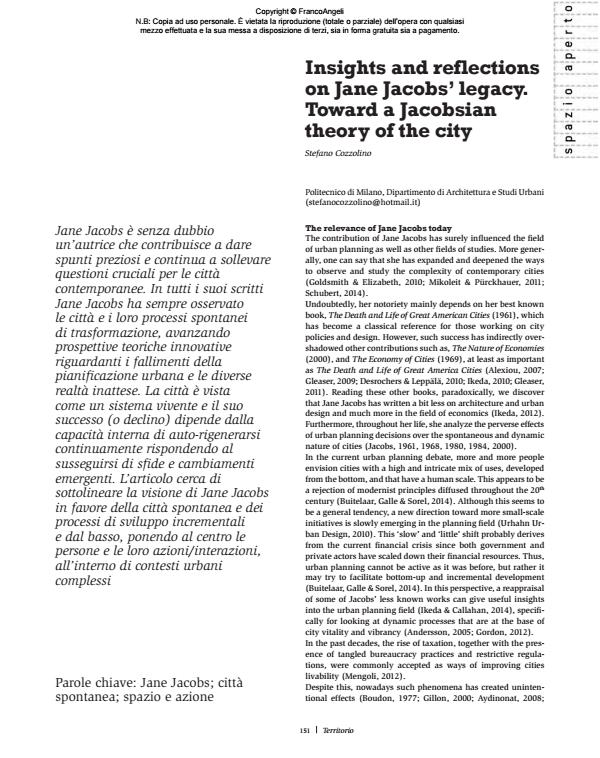Insights and reflections on Jane Jacobs’ legacy. Toward a Jacobsian theory of the city
Titolo Rivista TERRITORIO
Autori/Curatori Stefano Cozzolino
Anno di pubblicazione 2015 Fascicolo 2015/72
Lingua Inglese Numero pagine 7 P. 151-157 Dimensione file 171 KB
DOI 10.3280/TR2015-072022
Il DOI è il codice a barre della proprietà intellettuale: per saperne di più
clicca qui
Qui sotto puoi vedere in anteprima la prima pagina di questo articolo.
Se questo articolo ti interessa, lo puoi acquistare (e scaricare in formato pdf) seguendo le facili indicazioni per acquistare il download credit. Acquista Download Credits per scaricare questo Articolo in formato PDF

FrancoAngeli è membro della Publishers International Linking Association, Inc (PILA)associazione indipendente e non profit per facilitare (attraverso i servizi tecnologici implementati da CrossRef.org) l’accesso degli studiosi ai contenuti digitali nelle pubblicazioni professionali e scientifiche
Jane Jacobs è senza dubbio un’autrice che contribuisce a dare spunti preziosi e continua a sollevare questioni cruciali per le città contemporanee. In tutti i suoi scritti Jane Jacobs ha sempre osservato le città e i loro processi spontanei di trasformazione, avanzando prospettive teoriche innovative riguardanti i fallimenti della pianificazione urbana e le diverse realtà inattese. La città è vista come un sistema vivente e il suo successo (o declino) dipende dalla capacità interna di auto-rigenerarsi continuamente rispondendo al susseguirsi di sfide e cambiamenti emergenti. L’articolo cerca di sottolineare la visione di Jane Jacobs in favore della città spontanea e dei processi di sviluppo incrementali e dal basso, ponendo al centro le persone e le loro azioni/interazioni, all’interno di contesti urbani complessi
- The (ir)relevance of economic segregation. Jane Jacobs and the empirical and moral implications of an unequal spatial distribution of wealth Edwin Buitelaar, Stefano Cozzolino, in Cities /2019 pp.23
DOI: 10.1016/j.cities.2018.02.027 - Urban density after Jane Jacobs: the crucial role of diversity and emergence Stefano Moroni, in City, Territory and Architecture 13/2016
DOI: 10.1186/s40410-016-0041-1 - Jane Jacobs is still here Roberto Rocco, (ISBN:9789461869005)
Stefano Cozzolino, Insights and reflections on Jane Jacobs’ legacy. Toward a Jacobsian theory of the city in "TERRITORIO" 72/2015, pp 151-157, DOI: 10.3280/TR2015-072022